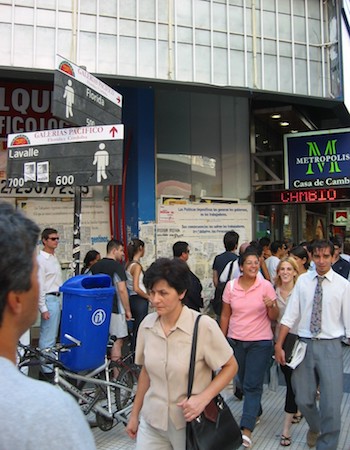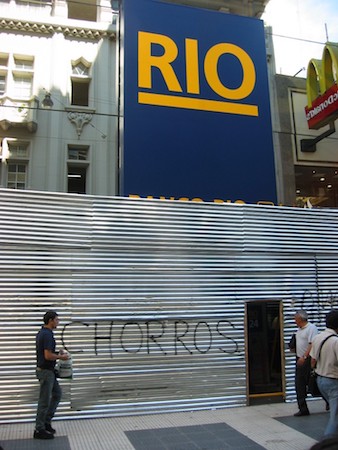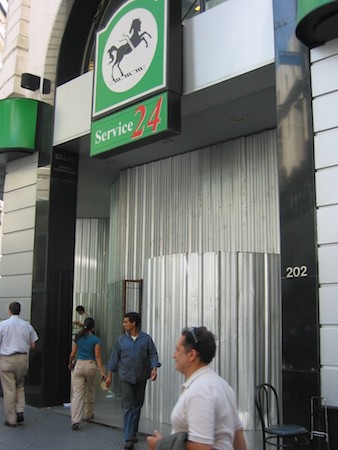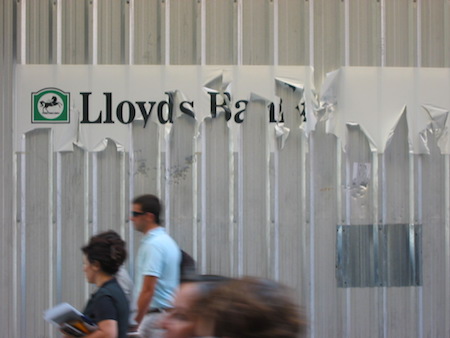
My first experience exchanging dollars to pesos in Argentina went surprisingly well. After over a decade of pegging the peso to the dollar (known as convertibilidad), most exchange places outside of downtown Buenos Aires had gone out of business. Also ATMs previously offered either pesos or dollars, but that’s not an option now. Everyone heads to the microcentro to exchange cash, so off we went too.

The thought of waiting in long lines wasn’t appealing, but I had zero pesos left & wasn’t sure how the new liberalization of the peso would be accounted for by my US bank. Sure, I could go to any ATM and withdraw cash from my checking account, but I had no idea what the exchange rate would be. I was already burned once after devaluation in early January, so I wanted to avoid any further problems. And after bringing cash with me from the US, I needed to use it sometime.
When I left for Seattle in January, Fabio told me about more attacks on banks. Their response? Place tin sheeting over all windows for protection… so attractive. At the moment all banks in the downtown area are shielded completely from view and some even have graffiti. Chorros = thieves in local slang.

Fabio and I walked around to compare exchange rates. After seeing the large variation —anywhere between U$S 1.60 and U$S 1.90— we happened to spot a place with a rate of U$S 1.85 & very few people waiting. The slightly lower rate seemed to be worth a shorter line and a spot in the shade. Fabio checked around the area in vain for a better rate while I took a place in line. I think we waited a max of 45 minutes for the whole process. Our line grew dramatically after I showed up… I just happened to be in the right place at the right time.
Their rate of $1.85 included any fee for the transaction (standard practice), so no one ever really knows what the official exchange rate is or how much they are being charged for the exchange. Likewise, all rates are displayed on tv monitors so depending on solvency, they can adjust their fee by changing the rate posted without giving notice. Sneaky, yet effective. There was one person behind us who kept hoping the rate wouldn’t change by the time his turn came. I only exchanged U$S 100 to have a little cash on hand… I was also speculating that the dollar will go up next week after the initial rush decreases. That’s the worst part of all of this: the speculation. No one has confidence in the value of the peso & everyone is looking out for themselves.

We purposely waited until about 15:30 to set out because lines in the morning are unbelievable. The only other interesting event was being approached by the arbolitos: people who stand on corners or walk by the lines outside exchange agencies wanting to exchange money themselves. Every so often you hear, “Cambio… cambio” meaning “exchange.” Arbolitos usually offer better rates than any exchange office, but there is the increased risk of doing a monetary transaction on the street. You have to check all the bills for the watermark and hope no one follows you home after seeing the exchange! This kind of unofficial transaction became common during the 1980s when hyperinflation made everyone’s money worth less and less on a daily basis.

I noticed from my online banking statement that the 50 pesos I withdrew from the ATM on Saturday were at the free market rate of U$S 1.98 even before the first official day of free market trading. It should have been U$S 1.40, but nothing is ever clear when it comes to banking in Argentina.
[Originally posted in Argentina Experienced, a website I created to document living in Buenos Aires after the 2001 economic crisis. Text has been edited for style. Definitions of econ terms can be found in the glossary. Politician biographies may help, as well as a summary of recent history & current events.]